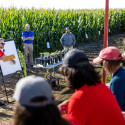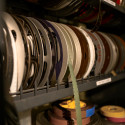UW-Madison advises cautious use of U.S. News rankings
U.S. News and World Report has ranked UW–Madison the seventh best public university and the 32nd best overall university in its “2004 America’s Best Colleges” rankings, but university officials advise potential students not to use the rankings to select where they go to college.
“It’s great to be ranked so highly year after year,” Provost Peter Spear says of being ranked seventh on the public university list two years in a row and eighth in the three prior years. “But, frankly, rankings such as this do not adequately represent the quality of this or any other institution.”
U.S. News reviewed 248 doctoral universities, of which 162 are public and 86 are private. The publication computes the rankings by looking at a list of indicators and assigning a weight to each indicator based on what the publication feels is most important.
U.S. News says a university’s score is based on peer assessment (25 percent of the score), student retention and graduation rates (25 percent), faculty resources (which include faculty-to-student ratio, salaries and degrees held by professors, 20 percent) how selective a school is when admitting students (15 percent), the institution’s financial resources (10 percent), and alumni giving (5 percent).
Spear noted much of the score depends on the resources the university receives from the state and alumni, not on the quality of teaching, research and service to the state that the university accomplishes with those resources. Notably, UW–Madison’s ranking of quality based upon peer assessments is fourth among public universities and 19th overall. In contrast, the university ranks 50th in financial resources and 119th in alumni giving.
“While the factors rated by U.S. News may be important things to consider, they are not the most important factors potential students should look at when choosing a college,” Spear says. “Students also should consider, among other things, a school’s strength in the academic programs that interest them, the advantages and disadvantages of the school’s size, the availability of student support services and advising, and the quality of student life.”
U.S. News also developed an unranked list of the 25 best institutions in a variety of undergraduate programs and initiatives that the publication says lead to student success. UW–Madison appeared on four of the lists, including: “first-year experiences,” “undergraduate research/creative projects,” “learning communities” and “study abroad.” The lists included both public and private institutions.
The report also ranks undergraduate business and engineering programs, with UW–Madison ranking 11th and 13th overall, respectively. Both rankings place public and private universities into the same pool.
Tags: research




